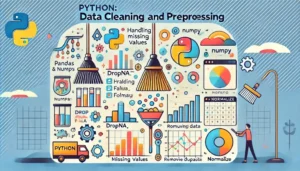Data cleaning and processing is crucial in any data analysis workflow, significantly impacting the accuracy and reliability of insights derived from data. These exercises will empower you with practical knowledge of cleaning, formatting, and transforming data using Python and pandas. You’ll learn how to manage missing values, normalize data ranges, encode categorical variables, and handle duplicates effectively.
Whether preparing datasets for machine learning, visualizations, or reporting, mastering data cleaning techniques ensures your analyses are built on solid foundations. By completing these tasks, you’ll enhance your ability to produce clean, consistent datasets, essential for making informed, data-driven decisions.
🚀 Jump Right to Exercise Tasks: Python Exercises – Data Cleaning And Processing
Handling Missing Values
Missing data is common and can distort analyses if not properly addressed. Filling or removing missing values is essential to ensure data integrity. Using pandas, you can conveniently handle missing data through methods like mean substitution, forward filling, and removal of incomplete rows.
Practical Example
Replace missing values with the mean:
import pandas as pd
# Original DataFrame with a missing value
df = pd.DataFrame({'B': [10, 20, None, 40]})
# Replace missing value with the mean of column B
df['B'].fillna(df['B'].mean(), inplace=True)
print(df)Example Solution:
B
0 10.0
1 20.0
2 23.3
3 40.0Key Takeaways:
- Effectively handle missing data with pandas methods like
fillna(). - Replacing NaN with mean values helps retain data consistency and analysis accuracy.
Normalizing Numeric Data
Normalization scales numerical data to a uniform range, typically between 0 and 1. This step is crucial when dealing with algorithms sensitive to varying scales, such as many machine learning models. Normalization ensures each feature contributes equally to analysis.
Practical Example
Normalize a numeric column between 0 and 1:
import pandas as pd
# Original DataFrame
df = pd.DataFrame({'B': [10, 20, 30, 40, 50]})
# Normalize column B
df['B_normalized'] = (df['B'] - df['B'].min()) / (df['B'].max() - df['B'].min())
print(df)Example Solution:
B B_normalized
0 10 0.00
1 20 0.25
2 30 0.50
3 40 0.75
4 50 1.00Key Takeaways:
- Normalization rescales data between 0 and 1.
- Critical step for algorithms sensitive to data scale, like neural networks.
Encoding Categorical Variables
Categorical data must often be transformed into numeric form for analysis. One-hot encoding, provided by pandas, is a common method where each categorical level is converted into a binary (0 or 1) column. This allows categorical data to be effectively incorporated into many analytical and machine learning models.
Practical Example
One-hot encode a categorical column:
import pandas as pd
# Original DataFrame
df = pd.DataFrame({'Color': ['Red', 'Blue', 'Red']})
# One-hot encode Color column
encoded_df = pd.get_dummies(df, columns=['Color'])
print(encoded_df)Example Solution:
Color_Blue Color_Red
0 0 1
1 1 0
2 0 1Key Takeaways:
- One-hot encoding creates binary columns for categorical data.
- Enables the use of categorical variables in numeric-based models.
What You’ll Gain from Completing This Exercise
These data cleaning exercises equip you with the practical skills to manage and preprocess datasets effectively. You’ll learn techniques for handling missing data, scaling numeric features, and encoding categorical variables, essential for accurate and impactful data analysis.
How to Complete the Exercise Tasks
Use the provided pandas environment:
- Write your Python code: Enter your solution into the editor.
- Run your code: Click “Run” to execute and verify your results.
- Check your solution: Ensure outputs match the expected results.
- Reset the editor: Click “Reset” to start fresh.
Earn XP, Unlock Rewards, and Track Progress!
If logged in, each task grants XP to unlock new levels, unique Avatars, and Frames. Your progress is saved automatically, helping you track your learning journey and achievements!


